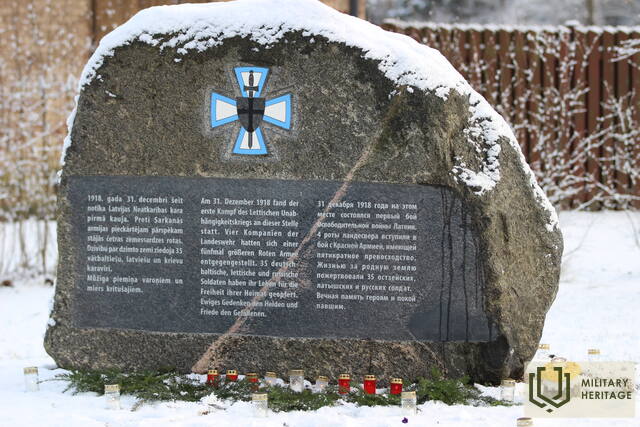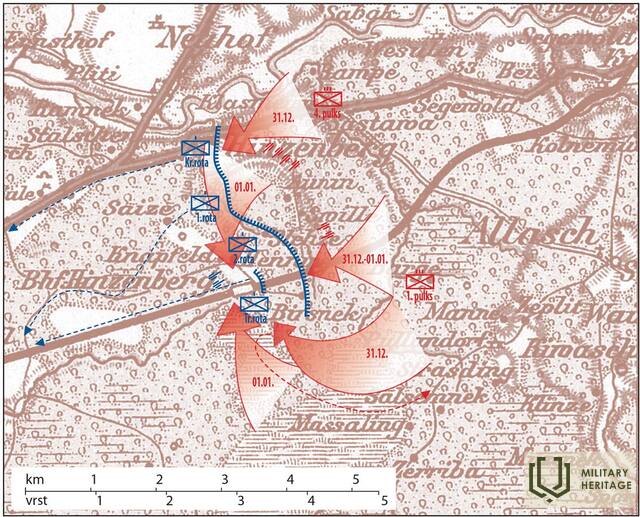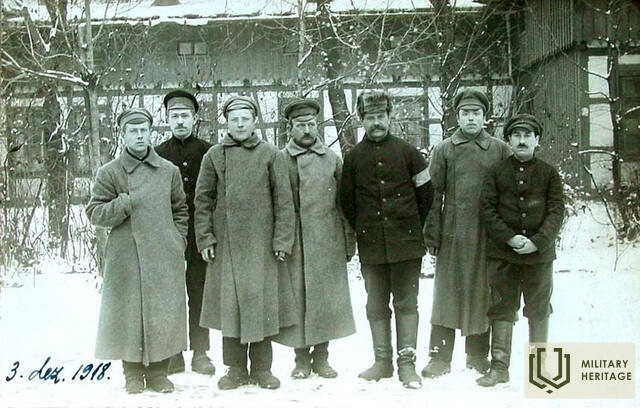Monument to the first battle for Latvia's independence
Memorial site

Located in Inčukalns, Atmodas Street 2.
On July 3, 2016, a monument to the first battle for Latvian independence was unveiled, dedicated to the Latvian Landeswehr (Die Lettländische Landeswehr), in which local Baltic Germans, Russians and Latvians, who were in units on both sides at the time, defended the newly founded state against the Bolshevik Red Army. Eižens Upmanis, the chairman of the Brothers' Graves Committee, concluded at the time that this could be the first monument to the combined Latvian and Baltic German forces in battle memorials outside the cemeteries. At that time, Lieutenant Colonel Oskars Kalpaks was appointed commander of the Latvian units of the Latvian Landeswehr, from whose units the later Latvian Army grew and formed during the Freedom Struggle.
In 1918, the entire territory of present-day Latvia had fallen into the hands of the German Empire and its troops. However, in the late summer and autumn of 1918, the situation began to rapidly turn against Germany and it was clear that it was only a matter of time before Germany would be forced to admit defeat in World War I. The Russian Empire, which Latvia was part of until World War I, had ceased to exist earlier, with the February and October revolutions of 1917. On 18 November 1918, the Republic of Latvia was proclaimed. The German army, which was located in the territory of Latvia, after the armistice with the Entente powers on 11 November 1918, was no longer motivated for further hostilities and most of its soldiers simply wanted to return to their homeland.
Under such circumstances, it was clear that the defense of Latvia depended primarily on a national guard formed by the Latvian population itself. Initially, due to their education and relatively greater ability to self-organize, the Baltic Germans living in Latvia showed the greatest initiative in forming such a national guard. Russian soldiers also joined the national guard. In order to ensure the supply of the national guard with uniforms, weapons and other necessary resources, the Latvian Provisional Government concluded an agreement with the German representative Augustus Vinnig on December 7, 1918, providing for the provision of the national guard from the German army reserves located in the territory of Latvia. This agreement indicated, among other things, that this national guard, with the official name “Latvijas zemessardze” or in German – “die Lettländische Landeswehr”, would be the armed forces of the Republic of Latvia.
The Latvian National Guard was confronted by two Latvian Red Riflemen regiments (i.e., approximately 2,000–3,000 soldiers) that had previously been experienced in World War I and the Russian Civil War. Despite the Red Army's experience and numerical superiority, the Latvian National Guard held Inčukalna in fierce battles for two days, until finally, on the evening of January 1, 1919, in order to avoid encirclement, it was forced to retreat, losing 43 killed and several wounded, most of whom were captured by the Bolsheviks, where they were killed or died of hunger or disease.
Author: Artis Buks. Material: Fieldstone. The monument is made of a large monolithic stone that was found in Ruļļi near Jelgava.
Used sources and references:
https://www.facebook.com/PirmaKaujaParLatvijasNeatkaribu/ (viewed: 23.05.2021)














